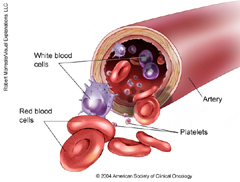This site includes information about the risk factors, symptoms, treatment, and statistics of leukemia. A general overview of the disease and background information is included below. For further references, see the works cited page and list of image sources.
What is Leukemia?

Types of blood cells found in the bone marrow
Leukemia is the cancer of the blood cells. It begins in the bone marrow, the soft tissue inside bones where all blood cells are made. In a healthy person, the bone marrow makes white blood cells which help your body fight off invaders, red blood cells which carry oxygen to all parts of the body, and platelets which help clot blood. In a leukemia patient, the bone marrow starts producing an excessive number of abnormal white blood cells, known as “leukemia cells,” which reproduce without regulation and don’t perform the proper infection-fighting function in the blood. Over time, they can crowd out the normal white and red blood cells as well as the platelets, leading to serious problems such as anemia, infection, and bleeding. These leukemia cells then enter the blood stream and are able to spread to other parts of the body such as the spleen, liver, and lymph nodes.
Are there different types?
There are four major categories of leukemia: Acute Myelogenous Leukemia (AML), Acute Lymphoblastic Leukemia (ALL), Chronic Myelogenous Leukemia (CML), and Chronic Lymphocytic Leukemia (CLL).
The description acute or chronic classifies how fast the cancer progresses. Acute leukemia gets worse very quickly and may make the patient feel sick immediately, while chronic leukemia worsens gradually and may not show symptoms for years. Whether the cancer is Myelogenous or Lymphocytic (aka. lymphoblastic) depends on what type of white blood cell it affects. Lymphocytic leukemia affects white blood cells called lymphocytes, while Myelogenous leukemia affects white blood cells called myelocytes.
Acute lymphoblastic leukemia is the most common form of leukemia diagnosed in children. However, adults can also develop it. Chronic lymphocytic leukemia is most common in adults, especially those older than the age of 55. CLL is extremely rare in children. Acute myelogenous leukemia affects both children and adults. Chronic myelogenous leukemia occurs mainly in adults.
The description acute or chronic classifies how fast the cancer progresses. Acute leukemia gets worse very quickly and may make the patient feel sick immediately, while chronic leukemia worsens gradually and may not show symptoms for years. Whether the cancer is Myelogenous or Lymphocytic (aka. lymphoblastic) depends on what type of white blood cell it affects. Lymphocytic leukemia affects white blood cells called lymphocytes, while Myelogenous leukemia affects white blood cells called myelocytes.
Acute lymphoblastic leukemia is the most common form of leukemia diagnosed in children. However, adults can also develop it. Chronic lymphocytic leukemia is most common in adults, especially those older than the age of 55. CLL is extremely rare in children. Acute myelogenous leukemia affects both children and adults. Chronic myelogenous leukemia occurs mainly in adults.
